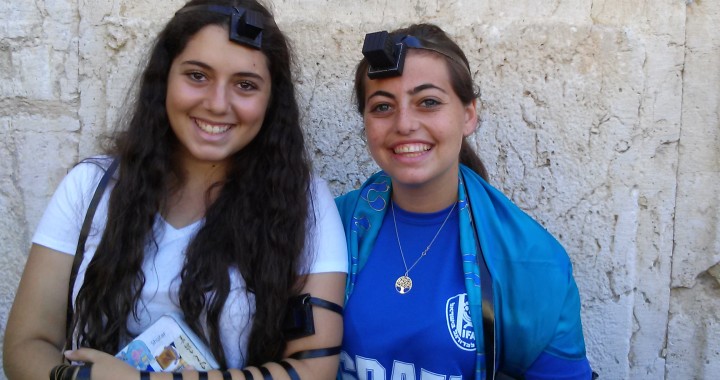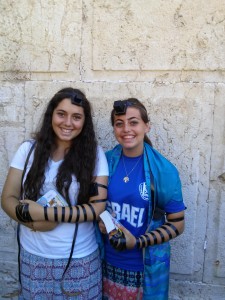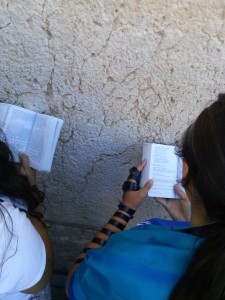It’s the last day of USY Poland-Israel Pilgrimage. We’re standing at Robinson’s Arch, in the “egalitarian” section of the Kotel, also known as the Western Wall. All 47 of us are there together, all by ourselves, ready to daven Sunday Shacharit. The men have kippot on, as well as a tallis and t’fillin. Some of the women wear a tallis, if they brought one on the trip. Before we start, I ask the women if anyone wants to wrap t’fillin, as I’d be happy to share mine for the second half of the service. After all, that previous Friday at Shacharit, the women had been taught how to wrap t’fillin, along with the reasons for why we do it. I think it would be especially meaningful for some of them to wrap at the Kotel. It turns out I’m right. Immediately after the question is raised, one girl shouts “I do!”. Taking my lead, a few of the other USY’ers pledge theirs for the second half of the service to any willing ladies who also want to wrap.
Business settled, we begin our service. Today’s leader is Briana, a USY’er from Florida whose T’fillah goal is to learn and lead a weekday Shacharit service. Standing next to her, calling pages and giving moral support, is Josh, a Rel Ed (a position on a USY board that oversees religious education for their chapter/region/country) who had both led many services on our trip and taught other USY’ers skills so that they could also lead. In a really moving and beautifully led service, all 47 of us pray together as one, each of us in our own way.
After the Amidah, I unwrap my t’fillin and hand it over to one of the ladies. I help her to wrap them, and she stands there, shoulder to should with others who have put on t’fillin, heads pressed against the great stones once supporting the Holy Temple, davening with intense kavannah (intention).
It’s such a moving scene, to see 42 USY’ers, Conservative Jews, taking on their role as young Jewish adults in such a reaffirming way. To see egalitarianism alive and thriving in this moment, in Israel, at the Kotel of all places, is inspiring.
Overlooking our platform where we’re davening, another tour group gathers, equally as moved by the experience. They stand there watching, and even join as we joyously sing the Shehecheyanu to celebrate Briana’s achievement. This excitement for Judaism, for ruach after meals, and even for prayer, is not an isolated incident on our trip. Time and again, these young USY’ers, some of whom may not have stepped into a synagogue since their B’nai Mitzvah (at least for services), prove that they’re willing and excited to partake in Jewish life in its fullest.
Are these youth outliers? Are they fundamentally different from all other American Jewish youth? Why, back home, are parents of children all across the nation asking, “Why isn’t my kid Jewish?”
“Why isn’t my kid Jewish?” I’m not here to judge what makes a person “Jewish”. That you can decide. But one thing that studies like the infamous Pew Report, and my own experience working in the Minneapolis Jewish Community has shown, is that in increasing numbers young Jews don’t identify as being Jewish. Many don’t practice Judaism on a day to day basis, a weekly basis, or even on a yearly basis. The idea of a 3 day a year Jew is an unfortunately prevalent one. Parents, synagogues, and communities have been brainstorming ways for years to change this trend, to limited success. But there have been shining stars.
“The success of the Jewish summer camp” and “experiencing Israel” have been rightly heralded for their outstanding work in creating knowledgeable Jews who are proud of their identity. How do they do it? There are many factors, but simply put, and I believe most importantly, there’s Jewish immersion.
For 1, 4, 8 weeks, Jewish youth at summer camps are, as a former camp director describes it, put in a secluded bubble and pelted from all directions with little tidbits of Judaism. Every action, be it eating, praying, playing sports, or art, is infused with Judaism and pride for Israel, both overtly and subconsciously. To many campers, saying HaMotzi before a meal or Birkat Hamazon is as much camp tradition or just another part of a meal as it is “prayer”. For many, ruach (song sessions) during Shabbat is a big highlight of their experience. Many don’t even realize that the words they sing are from our t’fillot.
An Israel experience is quite the same, in the sense that a Jew often feels completely “at home” as a Jew in Israel. To be a Jew in Israel does not make you different and restrict you from actions, as it might in America, but it connects you to the majority of the people around you. The language, the ability to wish anyone on the street a Shabbat Shalom on Friday afternoon, the ability to go into almost any restaurant you want and be able to order anything from it, all add to this feeling of Jewish immersion.
So when my Rabbis and community ask, “How can we bring the success of camp and Israel back into our community?”, the answer is not the one that they want to hear, because it is the one they have the least control over. While synagogues and communities can certainly do more to offer meaningful, engaging, and fun programming, and they can create excitement at their events similar to a camp atmosphere, the issue of Jewish engagement, and the ultimate solution, lies with those same people who are asking “Why aren’t my children Jewish?”. The issue, and the solution, lies with the parents.
It lies in the parents who drop their children off at Hebrew school on Saturdays, and then go to yoga class (or worse, the parents that bring their children late because they were at yoga). It lies in the parents that prioritize a high school football game over a Shabbat dinner. It lies in the parents who took a break from Judaism at age 13, and who forgot to come back 30 years later.
Judaism is not just a series of blind acts of faith, one followed by another. It is a series of lessons and values that makes us better people and guides how we should treat others in this world. Shabbat teaches us the importance of family, of differentiating between right and wrong, of the value of time. Kashrut teaches us the value of treating everything in this world with respect, care and dignity. Prayer teaches us the value of community and personal reflection. If not from Judaism, where are our children learning these lessons? From TV? From their friends? From popular culture?
Jewish children need Jewish immersion. They crave Jewish immersion, and are inspired by Jewish immersion to live more “Jewish” lives. The success of Jewish camps and Israel trips is impressive and important. But how much more of an impact can it have coming from a parent? From your first heroes in life? From the people you model yourself after and in many ways become? This is how we renew Jewish life.
Parents, you don’t have to do all. Start small and choose one thing. Light the Shabbat candles on Friday night. Bless your children before Friday dinner. Go to synagogue with them on Saturday mornings. Try not mixing milk and meat in your meals. Only eat kosher animals, even if the meat itself is not kosher. By doing these things, you’re showing your children that you care about Judaism. You’re showing them that it’s important to you. Only then will it become important to them.
Immersion in many ways is a relic of the past, but it is also the future. Jewish camps and Israel trips have figured this out. Will our families figure it out too before it’s too late?






